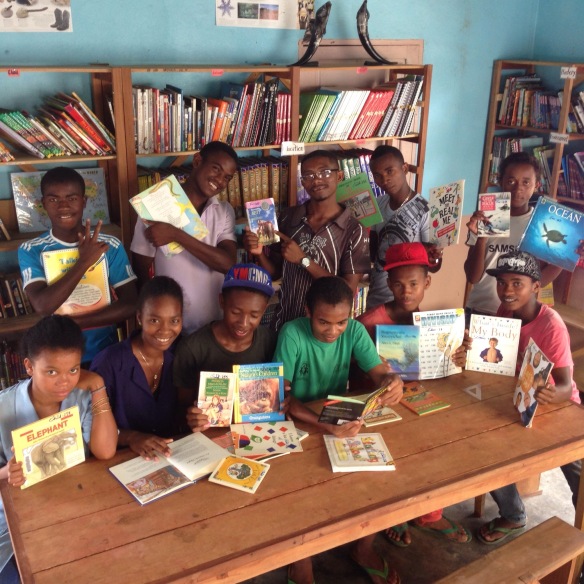With each new day, as I wake with the gentle light of dawn peering through the cracks of my wood shuttered window and the persistent chorus of roaming chickens and ducks, I become more aware of the new world around me. Every day I have the opportunity to meet someone new, eat a new food, learn something new, get bitten by a new bug. When I reflect on my understanding of the world just 6 months ago, I feel like I am now in one of the farthest corners of the globe that I could have imagined. How did I get here? Now that I am here, what should I be doing? How can I work to transform here into home?
On August 29, 2014, I was officially sworn in as a Peace Corps Volunteer. During the ceremony, a senior member of the Peace Corps staff delivered a speech that included some advice for our group of new Volunteers. One line in particular moved me when he said, “Thank you for choosing to integrate into your new host communities…” Like a blast of fresh air, his words hit my face and I immediately felt the atmosphere change. I had not previously appreciated the idea of integration from the perspective of choice, but it became very clear as he continued to deliver his remarks. It is up to me to decide how much I want to be a part of my new community. Assimilation does not happen passively or from behind closed doors. I must choose to be an active member of my community from the start and remind myself of this principle when future days seem dark or lonely.
With this new perspective and feelings of excitement and optimism, I arrived in my new community four days after the ceremony. Other than some anecdotal stories from Volunteers who had visited in the past, I had little knowledge of what Andapa would actually be like. My very first glimpse of the town was as our car made a turn in the road coming down one of the many lush green mountains that surrounds the fertile farmlands. That’s when I knew it was real. That’s when I felt that the adventure had only just begun.
The town
Andapa is located in the SAVA region of Madagascar, which hugs the north east coast of the island. If you were here with me, I’d show you where that is using the helpful map of Madagascar that my left hand becomes when I extend all my fingers and hold them next to each other (I’m sort of up by the tip of my left ring finger). Andapa is one of the four principal cities in the region, along with Sambava, Vohemar, and Antalaha, and together they form the SAVA acronym that this region is named after. The region is best known for it’s vanilla production. Based purely on personal observations, Andapa seems to be a medium size Malagasy town with a population around 20,000-30,000 people. The town is about 104km (64 miles) from the coast and it is surrounded by huge mountains that contain the town like a washing basin. A local man recently told me that this area used to be a hotbed of geological activity, which supports the idea that Andapa is nestled in an ancient volcanic crater. The thick vegetation and formidable geographic features made quite an impression on me as I approached the town initially.
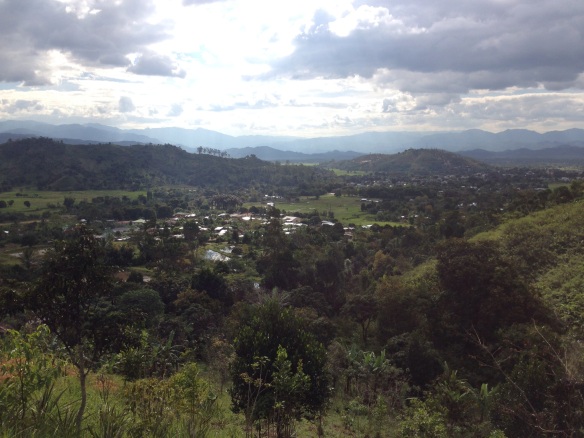 View of the Andapa basin with the town in the foreground.
View of the Andapa basin with the town in the foreground.
The climate was another aspect that stood out to me. On the day that I arrived, the sun was beating down with what felt like a physical presence on the back of my neck. Compared to the previous three months I had spent in the cool and overcast highlands, the heat was almost a refreshing change. I quickly learned, however, that Andapa is also notorious for it’s frequent rain showers. In my time here so far, it hasn’t rained for more than 20-30 minutes at a time and the rain usually comes in waves during the afternoon hours and overnight. Locals claim that Andapa’s “dry season” last for a mere two months in October and November, the rest of the year is what they consider to be wet. I have only met one person here that likes the rain.
The community
Two things stand out to me when it comes to describing the inhabitants of Andapa: extremely friendly and avid English speakers. In general, Malagasy people seem to pride themselves on having a culture that values hospitality and genuine friendliness. But the people of Andapa have shown me a whole new level of friendliness that I was not expecting. When I bring it up in conversation occasionally, some say it is an attribute of the Tsimihety people (one of the many tribes in Madagascar, based on traditional ancestry, and the principal ethnic group of people in Andapa and much of the SAVA region). No matter what the root cause is, it has helped make my adjustment to this town much easier. I also consider myself lucky because the previous Volunteer in Andapa had a few close Malagasy friends here and they each came to my door in the first few days and took me in like we had also been friends for many years. People that I had not known for more than a few hours were inviting me into their homes for meals and walking around town with me to introduce me to even more of their friends. I was also taken back by how many people, young and old, speak even basic English. And on top of that, they are also extremely motivated to practice and improve their English by conversing with a native speaker such as myself. I’m happy to oblige their excitement and in return I ask them to help me learn a little more Malagasy each day. The librarian at the only English language library (a project started by a previous PCV) has told me that there are more than 200 members in the town’s English club! In addition, there is an Adventist church that offers an English language service each week. The number of people in Andapa that are willingly exposed to English on a daily or weekly basis is, in my option, astounding for a town this size. I’m very much looking forward to working with such a mizoto (motivated) crowd and hopefully instilling more excitement for English in some of the younger students I will teach.
I’m slowly discovering that my new community is filled with some delightful characters. In my mind, there is the retired high school gym coach who owns an épicerie. There is the tired-looking guard with a deep raspy voice that might as well be a blues musician in 1950s Detroit. There is the eccentric aunt in the countryside who jokingly chases after me on my runs just to get a rise out of her nieces and nephews. There is the excited drunk who sees my white face in the crowd and just wants a high-five. And almost every day I meet a new character in the cast.
In Andapa, there is a whole boulevard about a mile long that is packed on both sides with small stores. It’s the main non-food shopping area in town and it’s busy every single day. There are four main types of stores here. The épicerie sells basic household items such as cooking oil, snacks, laundry soap, pasta, candy, batteries, etc. Another store sells just clothes. The clothing donated to popular charity stores in America does in fact eventually make it’s way to developing countries like Madagascar. There are other places that are similar to hardware stores and they sell nails, rope, bicycle parts, flashlights, plastic buckets, etc. Finally there are movie and media stores that sell DVDs of fairly recent films, usually in French voice overs, and music. When I first arrived, I was also amazed at the size of the market and quickly recognized that I could buy almost anything that I need in this town. When I go shopping here, the sellers tend to be very polite to me and they appreciate when I try to speak Malagasy with them.
There are a couple food markets in Andapa where I can find fresh produce, rice, beans, bread, and meats every single day. From speaking with other Volunteers, a daily market of this size is sometimes a rare thing. The best way I can describe the market is to say it’s like a farmer’s market in America. The road is lined with stalls where women, usually, can sell produce or sometimes they simply spread out a plastic tarp on the group and sell from there. Almost everyone sells the same things, but I’m learning to purchase certain items from certain people. For example, there’s a woman that sells great bananas and usually gives me a cadeau (French for “gift”, it means they give you a little more than you pay for as a sign of respect or good faith. In this case, I get an extra banana for free) but her tomatoes are not that impressive. I buy tomatoes from someone else, same with carrots and onions and so on. I’ve found that this technique has two benefits. On the one hand, I feel like I can integrate into the community better if I have interactions with more people and can establish more friendly faces. On the other hand, some of the vendors that I go to often recognize me and they make an extra effort to pick out some of the better produce for me. They get the pride of selling to a foreigner and I get great food, we all win! Buying meat is a whole other story. I can now appreciate why the butchers in American supermarkets have the majority of their work stations behind closed doors. But without the gory details, buying meat in Madagascar is an art that I’m determined to practice. For now, I only buy beef from butchers that my Malagasy friends buy meat from. I don’t buy chicken because the only way to get chicken meat is to buy a live chicken and butcher it in the comfort of your own home. There is pork as well, but I’m not ready to buy that quite yet. Due to Andapa’s distance from the ocean, there’s not as much fresh fish available here compared to other cities in SAVA but there is a wide variety of dried fish available that I politely stay away from. In recent conversations that I’ve had with Malagasy people, I find myself having to explain that in America we rarely get to see where our food comes from. But in Madagascar, the towns are all surrounded by farmland and livestock is usually part of the average household. People can sometimes walk 5 minutes out of the city, see what a field of green beans looks like, and then see those same beans in the markets. There seems to be a greater understanding, not necessarily appreciation, of how the food that we eat gets to our tables.
The house
I am very fortunate to have my housing provided by the local CISCO, which is the equivalent of a school district. I live on a small compound that also contains the CISCO offices and a couple other small homes, so during the week there are always people walking around from office to office and conducting business at the CISCO.
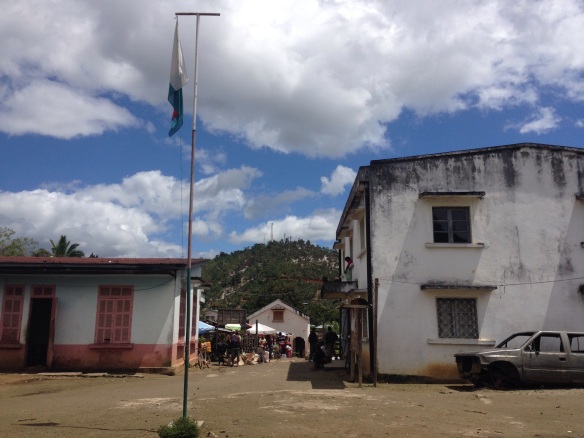 View looking from my kitchen and open window into the public courtyard. The CISCO offices are on the right.
View looking from my kitchen and open window into the public courtyard. The CISCO offices are on the right.
My home is a converted office and it can’t be much larger than 20 feet by 15 feet, including the bathroom. It’s small and cozy, but it really is just the right amount of space to live very comfortably. Some of the amenities I have are electricity (usually reliable), running water, a flush toilet, a shower, and a small refrigerator. It’s certainly leaps and bounds more than what I prepared myself for when I was still in America. For perspective, I could theoretically sit on my toilet and take a shower at the same time. Or I could lean the other direction and brush my teeth in the sink. I also have a full size bed, a small table with two chairs, and another longer table that serves as my kitchen area. The Volunteer who lived here previously was incredibly kind enough to leave many of her home goods here so when I moved in it was nearly fully furnished. I have a wonderful big window above my kitchen space that opens up into the compound and I usually keep that open when I am home. Although my home is a converted office, I am still living between two currently used offices and I get the pleasure of greeting these CISCO employees when they come to work in the morning. My home is also two doors away from the Andapa Public Library, which is the town’s only English language library and where I will likely be doing plenty of work during the next two years.
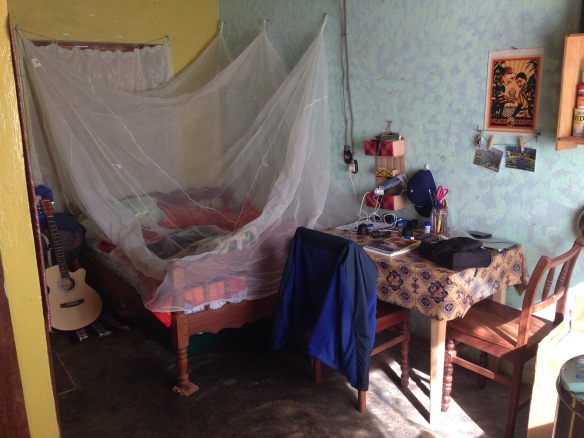 Inside my house, looking toward the bed and desk.
Inside my house, looking toward the bed and desk.
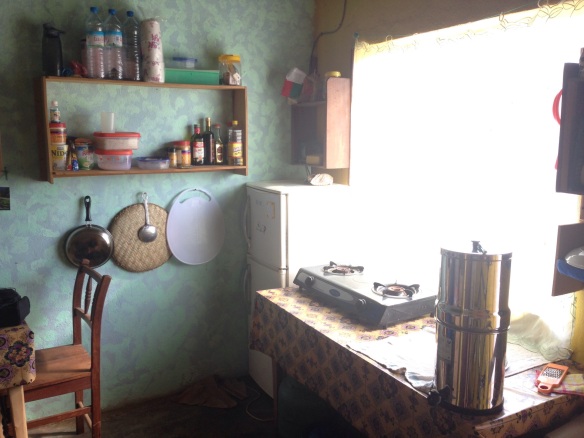 Inside my house, looking toward the kitchen area and window out to the courtyard.
Inside my house, looking toward the kitchen area and window out to the courtyard.
Shortly after arriving in my new home, I realized that this is the first time in my life that I’ve lived alone. In years before I’ve either lived with family or roommates, but never had an entire space all to myself. And now I do, or at least I don’t share this space with any humans. I do, however, have a family of bats that shares at least the roof with me. I was told about the bats even before I moved in, but I didn’t realize that they live inside the house. For the most part, it is a perfectly harmless and symbiotic relationship. They squeak and make a fair amount of noise as they shuffle between the roof and the small holes in the upper walls, but they have not flown inside the house. Yet. Sometimes they are very chatty in the evenings when I am in bed and I imagine that they are plotting an attack against me, but no such insurrection yet. They are the most active during dusk and dawn, when I assume they go out to hunt at night and return in the morning. I also like to think that they help me by hunting some of the other critters that I wouldn’t want in my house either. Speaking of which, I also get the occasional gecko that finds it’s way through a slit in the wall to explore my pantry. They’re harmless and I find it entertaining to watch them wiggle up and down the walls, for a short time at least. I’m learning that living in Madagascar means living with the natural world around me, no matter how animal-proof my house may seem. Even with bats and geckos, it sure beats having cockroaches and I am eternally thankful for not having those at home. Yet.
The work
While I am serving as a Volunteer in Andapa for the next two years, I have a primary project and I’m expected to develop other secondary projects for the community. My primary project is teaching English. As I mentioned in a previous post, I’ll be teaching at two schools that are the equivalent to public middle school and high school. As of now, I don’t have any more details about that because school doesn’t start until October 6th. This means that most students are away from town visiting family and I’m basically on summer vacation. But I really am looking forward to meeting the students and working with more of a defined schedule.
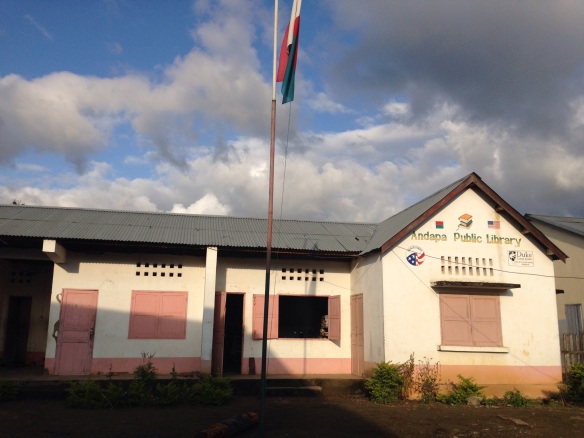 Looking toward the Andapa Public Library (far right) and my home (far left).
Looking toward the Andapa Public Library (far right) and my home (far left).
My secondary projects are still undefined, and Peace Corps encourages us to create projects that are of more personal interest to us while still meeting the needs of the community, but I have a pretty good idea already of the direction that I might want to work toward. Luckily I live next to the Andapa Public Library and can continue to support the efforts of that library. The project was started by a previous Volunteer and it has only been fully functional for a little more than a year. The library holds hundreds of English language books, most of them donated by people and organizations in America. The library is also used as a meeting space for the English Club, which I hope to continue facilitating during my service. Based on the incredibly motivated and interested students and adults that I’ve met so far, I can’t wait to meet more club members and help them practice English. Working with the library and the English Club are both things that will begin to blossom in October when students return to school.
During my first few months at site, especially now that I am not formally teaching, my main objectives are to integrate into my community, identify key people that I can work with in different capacities, and learn about what the people of Andapa need and want from me. The idea is simple: I have to know my community before I can provide assistance. I didn’t come here with specific projects in mind to impose on everyone, but instead I need to build my credibility and listen to what people have to say. Even in the first couple of weeks here, I can already see the relationships forming and soon enough I’ll be able to understand what the local community needs me to do.
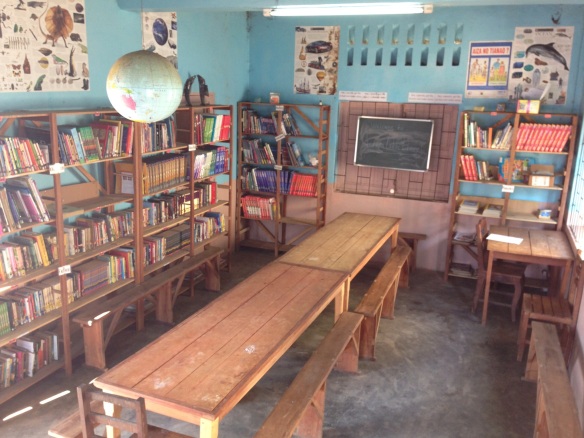 Inside the Andapa Public Library.
Inside the Andapa Public Library.
The average day
When I wake up in the morning, I usually have no idea what I will be doing that day except for a couple things that have started to become routine. Particularly now, when I’m not teaching and I’m not on a schedule, there are a lot of hours in the day to fill.
I typically wake up at 7:00am and crawl out from underneath the mosquito met covering my bed. I throw on some jeans and a t-shirt and I walk a few blocks to buy a cup of coffee. There’s a sweet lady that sells coffee, bread, and a hot breakfast soup made from soy and she doesn’t mind having an awkward vazaha (foreigner, usually French) visit her every morning. I slowly sip the coffee loaded with sugar while I listen to her speak with other patrons, hoping that I can pick up a new Malagasy word or two. Although at 7 in the morning, I’m not doing any learning. After the caffeine and sugar rushes kick in, I walk back home and have a light breakfast, maybe a banana and piece of bread. Then the next 4-5 hours until lunch are usually pretty up in the air. Sometimes I go for a run in the mornings and endure the odd stares I get from locals. Sometimes I do my laundry, washing everything by hand and hanging it to dry in the middle of the compound. Mostly I shop for food, hoping to get the more fresh items in the morning before the heat of the day wilts most of the vegetables. I’ll often walk around town, talk with people as they pass by my porch, or practice playing guitar (a personal development project I’m working on for the next two years). At around noon, I start to prepare my lunch and eat at home. I hope to use this time better in the future by inviting new friends over for lunch or sharing a meal in their homes. Sometimes after lunch I take a nap because, well, why not? In the afternoons, when the sun is strong, I sometimes stick to more indoor activities like reading, watching TV/movies on my computer, doing some light cleaning, or practicing guitar again. When the weather is more tolerable, I’ll be outside again walking and talking and generally showing my face around town. In general it’s another 4-5 hours to fill before dinner. Most of the time I cook a double portion of food at lunch so I don’t have to cook, or clean the dishes again, in the evenings. I’ll spend another hour or two relaxing at home after dinner and then I’m usually in bed between 8:00-9:00pm. I toss and turn on my foam mattress as the bats giggle above me, wake up the next morning and do it all over again. However, Sundays are exceptionally slow because almost all the stores are closed and most people are in church.
Overall, I feel like my adjustment to my new life has been going remarkably well. The first few days alone were rough and I can admit that I cried a lot when the Peace Corps car eventually drove off and I was left by myself. But each day I got out of my house for a few more minutes and I began to explore the new world around me. It has become more familiar, which makes it more comfortable, and I know soon enough I will truly feel at home here. I expected the emotional rollercoaster and I know the next two years will be filled with many highs and lows, but I also know that is a “normal” part of this experience. I can already say that the good times I’ve had here so far are worth the very few times I’ve felt lonely, scared, or sad. I’m learning to wake up in the morning and make the best of what I have in front of me, after getting coffee of course. I try to follow the advice of my Country Director when she says, “take each day as it comes and just stay in the here and now.”
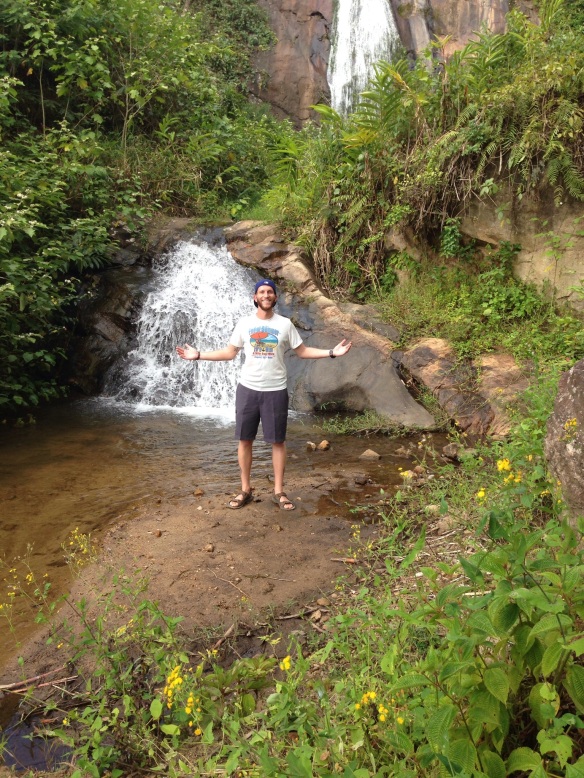 Me standing near part of a waterfall in the mountains surrounding Andapa.
Me standing near part of a waterfall in the mountains surrounding Andapa.



